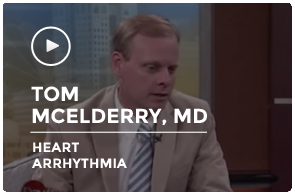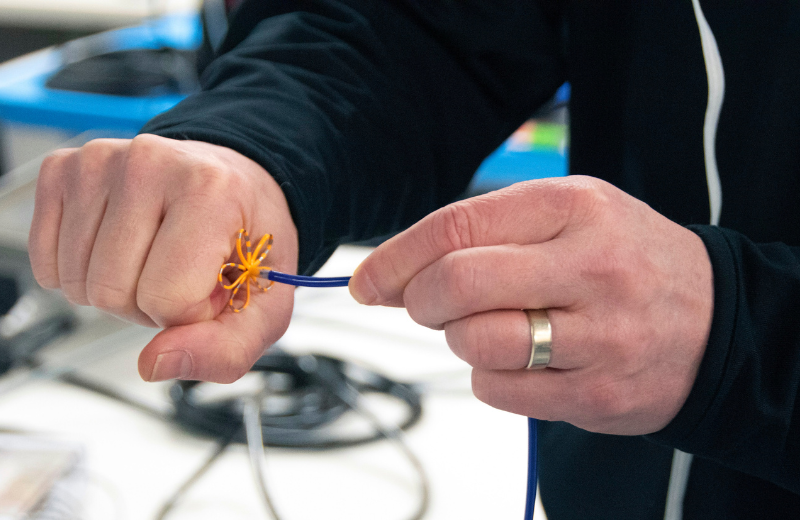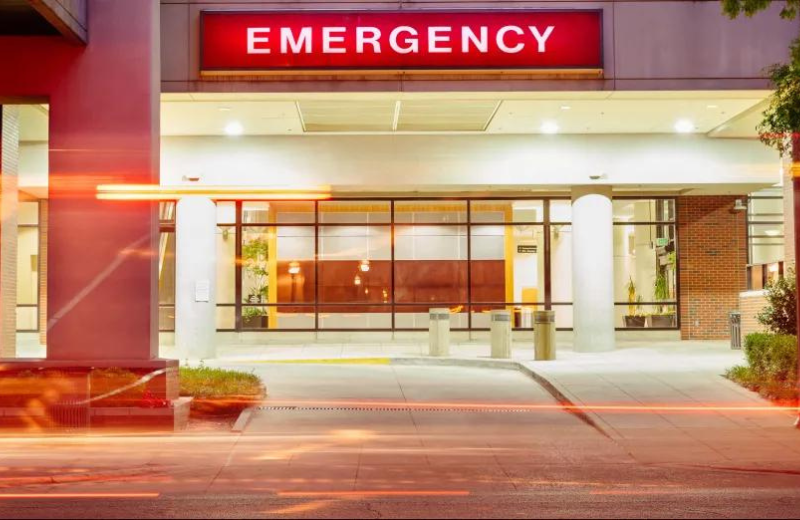What is Ventricular Tachycardia?
Ventricular tachycardia (VT) is a type of arrhythmia in which an electrical signal is sent from the ventricles at a very fast, but often regular, rate. If the heart rate is sustained at a high rate for more than 30 seconds, then VT is a potentially life-threatening condition. Cardiac arrest may occur. A person in VT may require an electric shock or medications to convert the arrhythmia back to normal sinus rhythm.
What are the symptoms of ventricular tachycardia?
If your heart rate during a ventricular tachycardia episode is extremely rapid or continues for several seconds, you may experience some or all of these symptoms.
- Sensation of feeling the heart beat (palpitations)
- Mild chest pain
- Some difficulty breathing
- Light-headedness or dizziness
- Fainting
How is ventricular tachycardia diagnosed?
There are several different types of procedures that may be used to diagnose VT:
- Electrocardiogram (ECG or EKG). An electrocardiogram is a measurement of the electrical activity of the heart. By placing electrodes at specific locations on the body (chest, arms, and legs), a graphic representation, or tracing, of the electrical activity can be obtained as the electrical activity is received and interpreted by an ECG machine. An ECG can indicate the presence of arrhythmias, damage to the heart caused by ischemia (lack of oxygen to the heart muscle) or myocardial infarction (MI, or heart attack), a problem with one or more of the heart valves, or other types of heart conditions.
There are several variations of the ECG test:
- Resting ECG. For this procedure, small sticky patches called electrodes are attached to the chest, arms, and legs. These electrodes are connected to the ECG machine by wires. The ECG machine records the heart’s electrical activity for a minute or so. The patient is lying down during this ECG.
- Exercise ECG, or stress test. During the test the patient exercises by walking on a treadmill or pedaling a stationary bicycle while the ECG is recorded. This test assesses changes in the ECG during activities, such as exercise, that cause stress.
- Electrophysiologic studies (EPS). A test in which a small, thin tube (catheter) is inserted in a large blood vessel in the leg or arm and advanced to the heart. This gives the doctor the capability of finding the site of the arrhythmia’s origin within the heart tissue, thus determining how to best treat it. Sometimes an attempt to treat the arrhythmia may be made by doing an ablation at the time of the study.
- Holter monitor. A continuous ECG recording done over a period of 24 or more hours. Electrodes are attached to the patient’s chest and connected to a small portable ECG recorder by lead wires. The patient goes about his or her usual daily activities (except for activities such as taking a shower, swimming, or any activity causing an excessive amount of sweating that would cause the electrodes to become loose or fall off) during this procedure. Holter monitoring may be done when an arrhythmia is suspected but not seen on a resting ECG, since arrhythmias may be transient in nature and not seen during the shorter recording times of the resting ECG.
- Event monitor. This is similar to a Holter monitor, but the ECG is recorded only when the patient starts the recording when symptoms are felt. Event monitors are typically worn longer than Holter monitors. The monitor can be removed to allow for showering or bathing.
- Mobile cardiac monitoring. This is similar to both a Holter and event monitor. The ECG is monitored constantly to allow for detection of arrhythmias, which are recorded and sent to your doctor regardless of whether symptoms are experienced. Recordings can also be initiated by the patient when symptoms are felt. These monitors can be worn up to 30 days.
How is ventricular tachycardia treated?
The doctor will choose a treatment based on the severity of symptoms being experienced, and the presence of other conditions (such as, diabetes, kidney failure, or heart failure) which can affect the course of the treatment.
- Lifestyle modification. The doctor may order the elimination of caffeine, alcohol, or any other substances believed to be causing the problem. If stress is suspected as a cause, the doctor may recommend stress-reduction measures, such as meditation, stress-management classes, an exercise program, or psychotherapy.
- If the doctor chooses to use medication, the decision of which medication to use will be determined by the severity of symptoms, other conditions that may be present, and other medications already being taken by the patient.
- Cardioversion. In this procedure, an electrical shock is delivered to the heart through the chest to stop certain very fast arrhythmias such as atrial fibrillation, supraventricular tachycardia, or atrial flutter. The patient is connected to an ECG monitor that is also connected to the defibrillator. The electrical shock is delivered at a precise point during the ECG cycle to convert the rhythm to a normal one.
- Ablation. This is an invasive procedure done in the electrophysiology laboratory, which means that a catheter (a very thin, flexible hollow tube) is inserted into the heart through a vessel in the groin or arm. The procedure is done in a manner similar to the electrophysiology studies (EPS) described above. Once the site of the arrhythmia has been determined by EPS, the catheter is moved to the site. By use of a technique, such as radiofrequency ablation (very high frequency radio waves are applied to the site, heating the tissue until the site is destroyed) or cryoablation (an ultra-cold substance is applied to the site, freezing the tissue and destroying the site), the site of the arrhythmia may be destroyed.
- Implantable cardioverter defibrillator. An implantable cardioverter defibrillator (ICD) is a small device, similar to a pacemaker, that is implanted under the skin, often in the shoulder area just under the collarbone. An ICD senses the rate of the heartbeat. When the heart rate exceeds a rate programmed into the device, it delivers an electrical shock to the heart in order to correct the rhythm to a slower, more normal heart rhythm.
- Surgery. Surgical treatment for arrhythmias is usually done only when all other appropriate options have failed. Surgical ablation is a major surgical procedure requiring general anesthesia. The chest is opened, exposing the heart. After the site of the arrhythmia is located, that tissue is destroyed or removed in order to eliminate the source of the arrhythmia.
Watch animation of catheter ablation procedure
UAB Cardiovascular Institute delivers optimal patient care for heart rhythm disorders. You will be cared for by regional and world leaders in the treatment of heart arrhythmias such as atrial fibrillation, atrial flutter, ventricular tachycardia, Wolff-Parkinson-White syndrome, atrioventricular re-entrant tachycardia, and other heart rhythm abnormalities.
Our physicians evaluate the newest treatments and technologies and author professional publications that advance the field of arrhythmia treatment. Their extensive experience and academic backgrounds ensure that they are familiar with all types of heart rhythm disorders. Our academic medical center performs more than 600 heart rhythm-related procedures each year, and our success in treating all types of complex arrhythmias is well-documented. Our electrophysiologists have access to the UAB Cardiovascular Institute, one of the largest of its kind in the Southeast. It features the most advanced technology available, including four procedural suites dedicated to electrophysiology (the electrical signals in the heart). At UAB Medicine you are part of a program that carries out pioneering work in atrial fibrillation and advanced pacemaker and cardioverter defibrillator design.
Videos

Find a Provider to Schedule an Appointment
Resources
Related Specialties
- Arrhythmia
- Atrial Fibrillation
- Cardiac Resynchronization Therapy
- Heart Palpitations
- Premature Atrial Contractions
- Wolff-Parkinson-White Syndrome
Clinical Trials
Speak to your physician about your options and browse the link below for more information
Latest News
View All News-
UAB relaunches Women’s Heart Health Program, now accepting patients
March 18, 2024
-
Research shows that Black individuals with a genetic mutation in the TTN gene have increased risk of developing atrial fibrillation, heart failure
March 15, 2024
-
UAB first in state and among first in the nation to use new technology to reduce atrial fibrillation complications
March 13, 2024
-
UAB-led study reveals that tracking troponin I over time is important for managing blood pressure and predicting risk of heart disease
March 12, 2024
-
UAB patient with congenital heart disease shares story to give others hope
February 23, 2024



